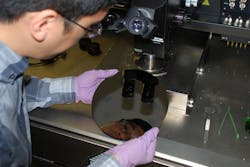For years now, technology has advanced very much in line with Moore’s Law, which states that computing power doubles about every two years. At the core of Moore’s Law is the number of transistors that can be placed on an integrated circuit, as this ultimately determines computing power.
Gordon Moore described this trend, which become known as Moore’s Law, back in 1965. So it’s no surprise that, nearly 50 years hence, many have been predicting an end, or at least a slowing down, in the shrinking of the transistor. The slowing was expected to start showing up somewhere around 2015-2020. The International Technology Roadmap for Semiconductors even predicted Moore’s Law to start slowing by the end of 2013.
Now comes news from the New York Times that scientists from IBM’s T.J. Watson Research Center in Yorktown Heights, N.Y., have used carbon nanotubes to create chips with as many as 10,000 transistors.
In addition to the number of transistors that can now be placed on a chip, carbon nanotube advances reportedly also increase the speed at which the transistors can be turned on and off. This has the effect of increasing computing clock speed. To better understand what this means in terms of how it will affect the devices we use, consider that increases in computer clock speeds have been slowing for years, which gave rise to use of multi-core processors now ubiquitous in computers and even smart phones. As carbon nanotube use in microprocessors advances, IBM scientists say it will be possible to dramatically increase computing speed as well as power.
Despite IBM’s breakthroughs with carbon nanotube technology, the predictions of The International Technology Roadmap for Semiconductors may still come to pass, as use of carbon nanotubes on microprocessors will not be perfected until some time after 2020.
So it looks like we’ll all have to be happy with the computing power levels we’ve become accustomed to for at least a few more years.
You can see a short video from IBM about carbon nanotube chip making here.
About the Author
David Greenfield, editor in chief
Editor in Chief

Leaders relevant to this article:
